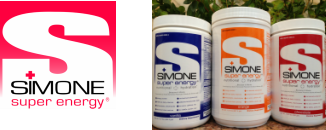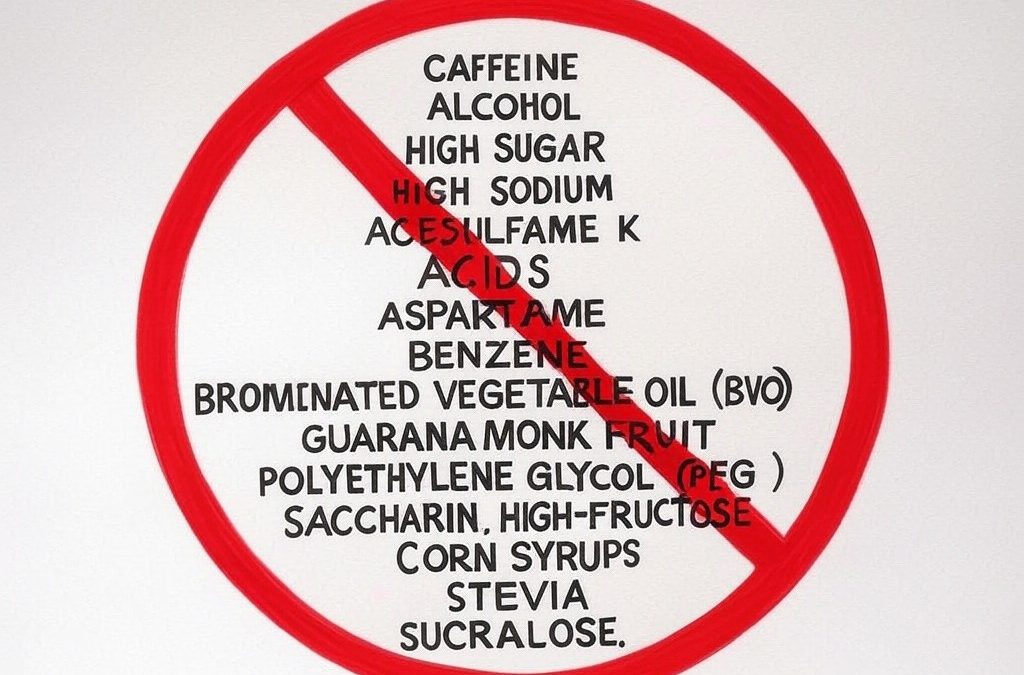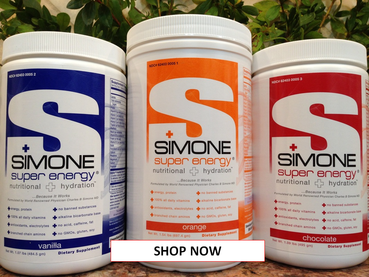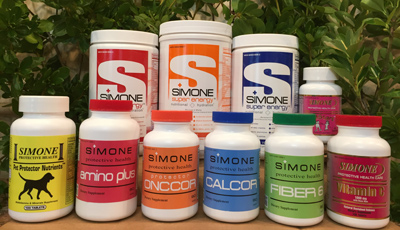We do not diagnose disease or recommend a dietary supplement for the treatment of disease. You should share this information with your physician who can determine what nutrition, disease and injury treatment regimen is best for you. You can search this site or the web for topics of interest that I may have written (use Dr Simone and topic).
“We provide truthful information without emotion or influence from the medical establishment, pharmaceutical industry, national organizations, special interest groups or government agencies.” Charles B Simone, M.MS., M.D.
HARMFUL INGREDIENTS TO AVOID IN YOUR DRINK
January 1, 2015
WHAT’S IN YOUR DRINK? HARMFUL INGREDIENTS TO AVOID
Lawrenceville, NJ (Dr. Simone) – What’s in your drink? What you put into your body will influence your performance and your overall health. Some popular energy drinks have been linked to 21,000 people forced to Emergency Rooms for care in 2011 and 18 deaths. Some energy and sports drinks contain so much acid that they erode tooth enamel. And some sports drinks have chemicals in them that are illegal in other countries. And some even have the same amount of sodium in them as the ocean. Would you drink ocean water? There is one drink now being whipped around the social media, probably by paid hired mercenaries, with 4.5 and 5 star ratings, that if you read the ingredients and know what they mean medically, you would never bring the drink into your home let alone into your body. I decided to write this blog because a retired PhD biochemist academic researcher and excellent senior marathoner told me he was using Simone but also was going to try this other one. I looked at the label and quickly saw multiple harmful ingredients to avoid.
So what’s in your drink? I’ll review some of the harmful ingredients to avoid. First, some general facts.
DO NOT DRINK LIQUIDS WITH:
• Caffeine, Alcohol, and Carbonation because these stimulate urine output and/or decrease voluntary fluid intake
• High sugar content like fruit juices, soda, carbohydrate gels, sports drinks that have >10% carbohydrate -10 grams/100 cc or 50 grams/500 cc
• High sodium because it causes dehydration and thirst. Slow absorption and cramps occur if drink has a high salt pressure – an osmolality >330.
• Water alone, especially large volumes, because water can dilute the bloodstream of electrolytes causing cardiac and neurological problems.
• Extreme temperatures – liquids that are too cold or too hot can adversely affect the heart’s electrical system as it passes to the stomach. Also, very cold liquid can swell the stomach’s lining that impedes the liquid’s entry into the bloodstream. Use an insulated container.
ACESULFAME K, 200 times sweeter than sugar, CAUSES CANCER IN ANIMALS, and increases the risk for cancer in humans. Acesulfame K contains the carcinogen methylene chloride (dichloromethane) that is used as a propellant in aerosol products, and used in the manufacture of paint stripping products, paint removal products, and adhesives. Side effects of methylene chloride in humans include: headaches, mental confusion, depression, nausea, and liver and kidney dysfunction.
Dr. Simone Recommendation: Avoid completely
ACIDS Citric acid and other acids are added to sports and energy drinks to improve taste and shelf life. But acids are a major enemy of an athlete because they impede performance. The athlete makes acid (lactic acid and ammonia) in muscles and often adds to this acid load by drinking these high acid sports and/or energy drinks. Also a recent study shows that tooth enamel is dissolved and permanently lost as a direct result of repeated short exposures to these acid sports and energy drinks. Tooth enamel loss after exposure to energy drinks was more than two times higher than it was after exposure to sports drinks. Simone Super Energy (www.SimoneSuperEnergy.com) has a high alkaline pH of 7.5 and has no acids.
Dr. Simone Recommendation: Avoid Acids completely
ASPARTAME, 200 times sweeter than sugar, International Agency for Research on Cancer (IARC) classified ASPARTAME as possibly CARCINOGENIC TO HUMANS. Aspartame also caused grand mal seizures in rats. Side effects in humans: headaches, joint pain, depression, anxiety attacks, slurred speech, cramps, vertigo and dizziness. When exposed to heat during hot summer temperatures inside uncooled warehouses, aspartame breaks down into toxic methyl alcohol that may cause recurrent headaches, mental aberrations, seizures, and suicidal tendencies. Aspartame is known also as phenylalanine, brand name NutraSweet.
Dr. Simone Recommendation: Avoid completely. In fact, the FDA should ban aspartame.
BENZENE CAUSES HUMAN CANCER
Benzene is a chemical that directly causes human leukemia and is implicated in causing other human cancers as well. No amount of benzene exposure is safe. Any beverage that contains BOTH vitamin C (ascorbic acid) and a preservative called benzoate (either sodium benzoate or potassium benzoate) can react to form benzene, especially if the beverage is left in the heat or exposed to light. In fact, the FDA reports that solutions containing ascorbic acid and benzoate preservatives “typical of those used in beverage formulations” that were left for eight days at room temperature had benzene levels of 266 ppb. And 79% of diet sodas have benzene in them. See my Report entitled, Benzene in Your Beverage. https://www.simonesuperenergy.com/benzene-in-your-beverages/
Dr. Simone Recommendation: Avoid completely
BROMINATED VEGETABLE OIL (BVO) an emulsifier that is banned in other countries. Bromine is used in some flame retardants, furniture and plastics. Some studies indicate BVO can build up in fatty tissues and cause reproductive and behavioral problems in rodents. It’s illegal to use BVO as a food additive in the European Union, India, Nepal, Canada, Brazil and Japan.
Dr. Simone Recommendation: Avoid completely.
CAFFEINE is a “MONITORED” SUBSTANCE by the World Anti-Doping Agency. Popular energy drinks contain high amounts of caffeine that can stimulate both the central nervous system and cardiovascular system. Caffeine levels in energy drinks range from about 80 milligrams (mg) to more than 500 mg in a can or bottle, while a 5-ounce cup of coffee contains 100 mg of caffeine and a 12-ounce soda contains 50 mg of caffeine. These energy drinks can also have other ingredients that may boost the stimulant effects of caffeine. This high dose is consumed all at once compared to 8 ounces of coffee with about 100 mg that is consumed over many many minutes thereby diluting the effects of caffeine with time. Caffeine also adversely affects calcium metabolism. Symptoms of caffeine intoxication include nervousness, cardiac arrhythmia, seizures, psychotic episodes and death.
Dr. Simone Recommendation: Avoid.
DOSES of Non-Harmful Ingredients – LOW DOSES OF NON-HARMFUL INGREDIENTS ARE VIRTUALLY MEANINGLESS to your body physiologically. For example, some flavored water drinks have only a few vitamins at low doses, 10% or 20% of the US RDI; and some drinks have ingredients with a large number next to the ingredient but designated in microgram (tiny) amounts.
GMO The World Health Organization defines Genetically Modified Organisms (GMOs) as “organisms in which the genetic material (DNA) has been altered in such a way that does not occur naturally.” GMO technology is also known as “genetic engineering”, “biotechnology” or “recombinant DNA technology.” Genetic fragments of DNA are randomly inserted from one organism to another, usually from a different species. Example: a combination of genes that includes a gene to produce the pesticide protein (Cry1Ab) is randomly inserted into the DNA of corn. Each time this insertion occurs the outcome is different: the location of the transferred gene sequence into the corn DNA and the outcome of the insertion differ. The cells that have taken up the inserted gene are then grown into plants in a lab that are used to grow GM food crops.
There are 60 countries in the world that require GMO labeling, but not the United States. Most corn, soy, canola, and sugar beets grown in the US are genetically engineered. GMO seeds have quadrupled in price.
The FDA does not require any safety assessment of genetically engineered crops. The FDA relies on the word of the applicant that the risk assessment supports whatever the applicant claims despite obvious flaws, ambiguous or uninterpretable results.
Scientific Concerns
The GMOs for maize, cotton, and soybeans are called Bt plants because they use a gene from Bacillus thuringiensis which is virtually indistinguishable from anthrax Bacillus anthracis.
Also, ricin, an extremely dangerous toxin, is structurally similar to the Bt GMO plants. And some Bt GMO proteins are toxic to human cells (Mizuki, 1999).
GMOs resist herbicides, so some farmers spray large amount of herbicides, and consequently some soybeans contain the herbicide Roundup (glyphosate – Monsanto).
Glufosinate, an herbicide (phosphinothricin) made by Bayer, is toxic to fungi, bacteria, and animals, and is also a neurotoxin to mammals. This herbicide remains in the plants for weeks or months later (Droge, 1992).
Most GMOs contain part of a virus called cauliflower mosaic virus (CaMV) or figwort mosaic virus (FMV) promoter. Both of these promoters have been shown to alter normal gene expression and consumers were eating these untested viral proteins.
Animals that have consumed GM food demonstrate serious health risks: infertility, immune system dysfunction, accelerated aging, dysregulation of genes associated with cholesterol synthesis, insulin regulation, cell signaling, and protein formation, and changes in the liver, kidney, spleen, and gastrointestinal system. Also, because of the mounting data, it is biologically plausible for Genetically Modified Foods to cause adverse health effects in humans.
Dr. Simone Recommendation: Avoid completely
GUARANA, BANNED SUBSTANCE, a stimulant, contains twice the concentration of caffeine found in coffee seeds (about 2–4.5% caffeine in guarana seeds compared to 1–2% for coffee seeds. Guarana also contains small amounts of theophylline and theobromine (the later is the chemical that makes chocolate poisonous to dogs and cats and is linked to HUMAN PROSTATE CANCER (Slattery ML, West DW. Smoking, alcohol, coffee, tea, caffeine, and theobromine: risk of prostate cancer in Utah (US). Cancer Causes Control.1993 Nov;4(6):559-63). Guarana extract reduced aggregation of rabbit platelets by up to 37 percent below control values and decreased platelet thromboxane formation from arachidonic acid by 78 percent below control values. It is not known if such platelet action has any effect on the risk of heart attack or ischemic stroke.
Dr. Simone Recommendation: Avoid completely
MONK FRUIT EXTRACT (mogrosides), 200 times sweeter than sugar, has been poorly tested in animals. There is an aftertaste of monk fruit. Monk fruit can also interfere with gut microbiota and induce glucose intolerance (https://www.ncbi.nlm.nih.gov/pmc/articles/PMC4661066/). Monk fruit can cause gastrointestinal upset, including bloating, gas, loose stools.
Many products combine other sweeteners with monk fruit extract — even if the product is called “pure monk fruit.” Some contain erythritol, a sugar alcohol that can cause bloating or stomach upset in some people. Research is also suggesting erythritol may be linked to heart attack and stroke. It is used in foods and beverages and sold as Nectresse.
It’s still unclear how monk fruit may impact your health because there are no scientific studies on the effects of long-term use.
.
Dr. Simone Recommendation: Avoid completely
POLYETHYLENE GLYCOL (PEG), a petroleum derived compound made from ethylene glycol, the main ingredient in antifreeze, gets converted to toxic oxalates. Polyethylene glycol is also used as a laxative, especially in preparation for colonoscopies. Side effects are listed as severe or bloody diarrhea, bleeding from your rectum, blood in your stools, severe or worsening stomach pain, cramping, bloating, nausea, bloating, vomiting, and dizziness. Do you really want to ingest a compound that forms toxic oxalates and is used as a strong laxative with lots of potential side effects that may occur during your workout or competition? Why put something in your body that will not benefit your health or your athletic performance?
Dr. Simone Recommendation: Avoid completely
SACCHARIN, 300 times sweeter than sugar, CAUSES CANCER IN ANIMALS: bladder, uterus, ovaries, and others. HUMAN CANCER risk is higher. The US FDA banned its use in 1977, but the US Congress permitted its use with a warning. Then Congress abolished the warning notice requirement in 2000. Saccharin negatively affects the microbiome and leads to poor glucose control even in the short term.
Dr. Simone Recommendation: Avoid completely
SODIUM Too much sodium causes stomach cramping and more thirst because it increases the osmolality and therefore has to be diluted by the body before it can be utilized. When a large amount of sodium is added to a drink, instead of getting fluid replacement, the body has to send its own fluid to the stomach in order to dilute that large sodium load. Some activity drinks have a large amount of sodium as the main, and sometimes, only electrolyte. There is virtually no scientific evidence that sodium in sports activity drinks can enhance the entry of water and glucose into the body.
The more sodium you consume, the greater is your need for more water intake.
High sodium intake decreases sweating by increasing the plasma osmolality.
Sweating gets rid of heat.
High sodium intake leads to hypertension and stroke. In fact, a 30 year old with hypertension has a 63% risk for cardiovascular disease and this develops 5 years earlier than a person with normal blood pressure (Rapsomaniki E et al. 2014. Lancet. 383:1899-1911).
High sodium intake causes 10% of all deaths globally.
The Military has shown that water alone can be used as a tactical weapon to prevent heat casualties.
Sodium supplementation is not necessary at all if you are eating a diet that normally has plenty of sodium (American diet has 6-18 gm of sodium per day).
Sodium loss of 11 to 16 grams can occur if you sweat about 12 liters in a day doing moderate work. But this loss is covered by your diet. In fact, no sodium supplementation is necessary after 6 hours of moderate exercise even in a hot environment.
Dr. Simone Recommendation: Avoid.
SUGARS
SUCROSE is composed of 50% glucose and 50% fructose. Sucrose is the sugar that is commonly added to foods for sweetness in biscuits, cookies, cakes, pies, candy, ice cream, sorbets, and beverages. It is a common ingredient in many processed and so-called “junk foods.” Sucrose is broken down and provokes a rapid rise in blood glucose that increases the risk for obesity, cardiovascular disease, cancer, metabolic diseases, renal complications, vision deterioration, and tooth decay. Some cancers have insulin receptors that allow glucose to attach and feed the cancer.
Dr. Simone Recommendation: Avoid completely.
HIGH-FRUCTOSE Corn Syrup is a misleading term allowed to be used in the US that represents a combination of glucose and fructose, just like sucrose. In this instance glucose is added to fructose to make the combination sweeter. In Great Britain and Canada, it must be called what it is: glucose-fructose.
Dr. Simone Recommendation: Avoid completely.
FRUCTOSE is the sweetest of all sugars and is found in many plants like fruit and corn. Fructose is absorbed directly into the bloodstream during digestion, then into the liver and not regulated by insulin at all. The gylcemic index of fructose is only 18. It should be non-GMO.
The GLYCEMIC INDEX measures how a particular sugar in a food will raise or lower the blood glucose level. Glucose, the sugar to which all other sugars are compared, is defined as having a glycemic index of 100 and all other sugars have a lower glycemic index. Foods that are digested quickly and release glucose rapidly into the bloodstream have a high glycemic index.
LOW GLYCEMIC INDEX FOODS: Fruits, vegetables, legumes, nuts, fructose (glycemic index is only 18), kidney beans, chick peas, converted white rice. I chose fructose as the sweetener for Simone Super Energy because it has a very low glycemic index and is not regulated by insulin.
MODERATE GLYCEMIC INDEX FOODS: Whole wheat products, basmati rice, sweet potato, sucrose, baked potato.
HIGH GLYCEMIC INDEX FOODS: White Bread, White rice, corn flakes, glucose, maltose, and extruded foods like pastas, many breakfast cereals, Fig Newtons, pre-made cookie dough, some French fries, certain baby foods, ready-to-eat snacks, Murukku, Sevai, Idiappam, and jalebi. In the extrusion process, raw materials are first ground to the correct particle size, then mixed with sugar or fat or dye, or meat etc.
SUGAR ALCOHOLS: Erythritol, Isomalt, Lactitol, Mannitol, Sorbitol, and Xylitol don’t have sugar or alcohol, but have half as many calories as sugar, except for Erythritol, which has 1/20 as much. Gastrointestinal distress can occur if you take in too much.
Erythritol increases the risk of heart attacks and stroke by promoting platelet aggregation and blood clot development.
STEVIA, from the Rebiana leaf (steviol glycosides), 200–300 times sweeter than sugar, it causes INFERTILITY in rats, is a MUTAGEN that may promote cancer by changing the cells’ DNA, is GENOTOXIC, and has not been adequately tested for cancer. The US FDA also was concerned that stevia might interfere with the absorption of carbohydrates and the conversion of food into energy within cells, as well as with effects on cardiovascular and renal systems. In the 1990s, the US FDA, Canada and the European Union rejected whole-leaf stevia and crude stevia extracts for use as a food ingredient. To be put on the “generally recognized as safe” (GRAS) list, the US FDA requires two-year feeding studies in both rats and mice. However, in 2008 the FDA accepted rebaudioside A as “generally recognized as safe” even though its cousin chemical compound, stevioside, and not rebaudioside A, was tested only in rats. In 2009, stevioside and other extracts were accepted on the GRAS list.
1991 – FDA banned stevia: a study showed it caused cancer.
1995 – FDA reversed and allowed it to be used only as ingredient and not as a sweetener
According to the FDA, there is not enough information to verify the safety of stevia leaf and crude stevia leaf extracts.
Stevia has an unpleasant aftertaste, and is sold under brand names as Truvia, Pure Via, and Sweet Leaf.
Dr. Simone Recommendation: Avoid completely
SIMONE SUPER ENERGY has no harmful ingredients. It has:
Energy without stimulants; Ribose
100% All Daily Vitamins
Antioxidants
Alkaline Bicarbonate Base
Electrolytes
Branched Chain Aminos
No Banned Substances
Compliant with WADA (World Anti-Doping Agency)
GMO Free
No Soy
No Gluten
No Acid
No Caffeine
No Fat
For Warriors and Athletes
For Everyday People
For People in Nursing Homes and Dieters
© 2022 Charles B. Simone, M.MS., M.D.



